Fire Ants and The Horrid Phorid Fly
Watching a Phorid Fly attacking a column of Fire Ants in the Arizona Desert
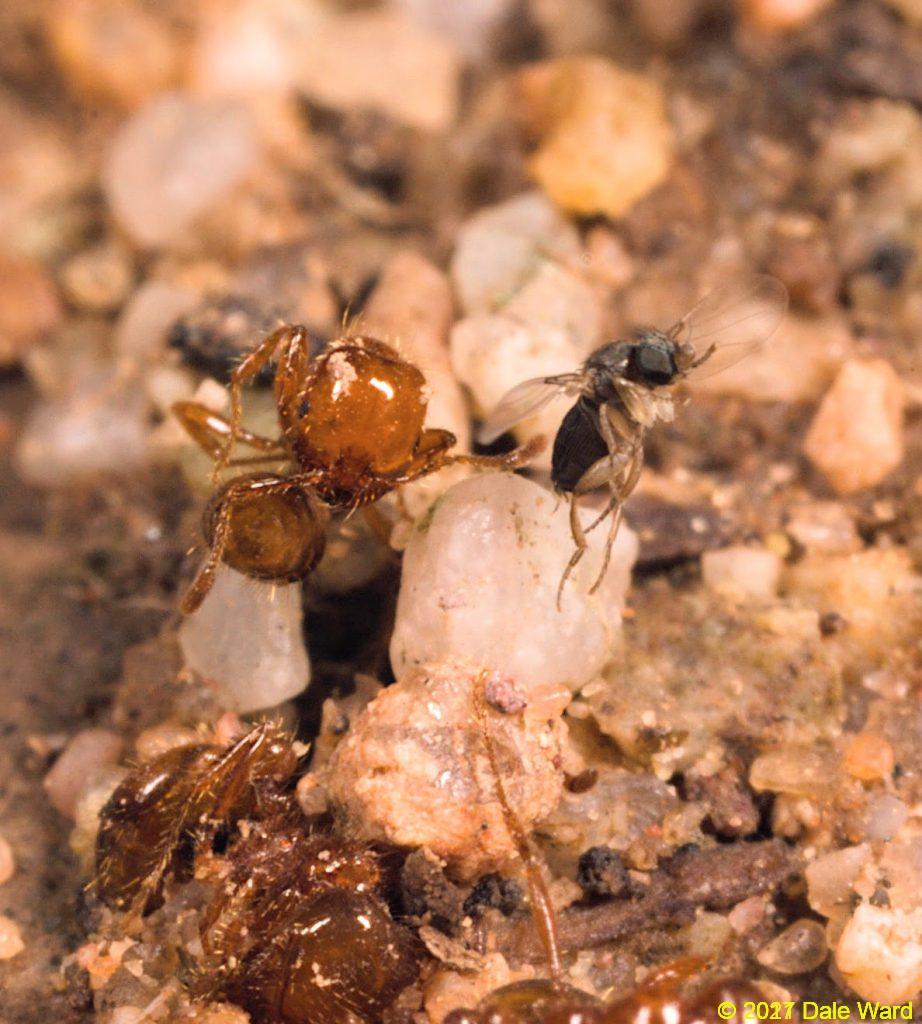 Phorid Fly darting making a pass over injured Golden Fire Ant (_Solenopsis aurea_) majors.
Phorid Fly darting making a pass over injured Golden Fire Ant (_Solenopsis aurea_) majors.
On an overcast afternoon in mid-August, 2005, I was walking through the Sonoran Desert just outside of Tucson. I came across a group of golden-colored ants fighting. The ants were small, no more than a few millimeters long.
They were a type of native Fire Ant - either Solenopsis amblychila or, more likely, the closely related Solenopsis aurea (the Golden Fire Ant). Usually I would see small groups of these ants on the extrafloral nectaries of cacti. It was unusual for me to see this many of them at once. It looked like a full-fledged war between the colonies.
What was especially interesting, though, was the presence of a small fly, a little bit bigger than a fruit fly. It would sit on a rock, watching the ants. Then every 10-15 seconds or so it would dart out and hover over the ants. The ants would go absolutely bananas when the fly did that.
Hmm. I thought. That sure looks like a Phorid Fly. Now that is exciting.
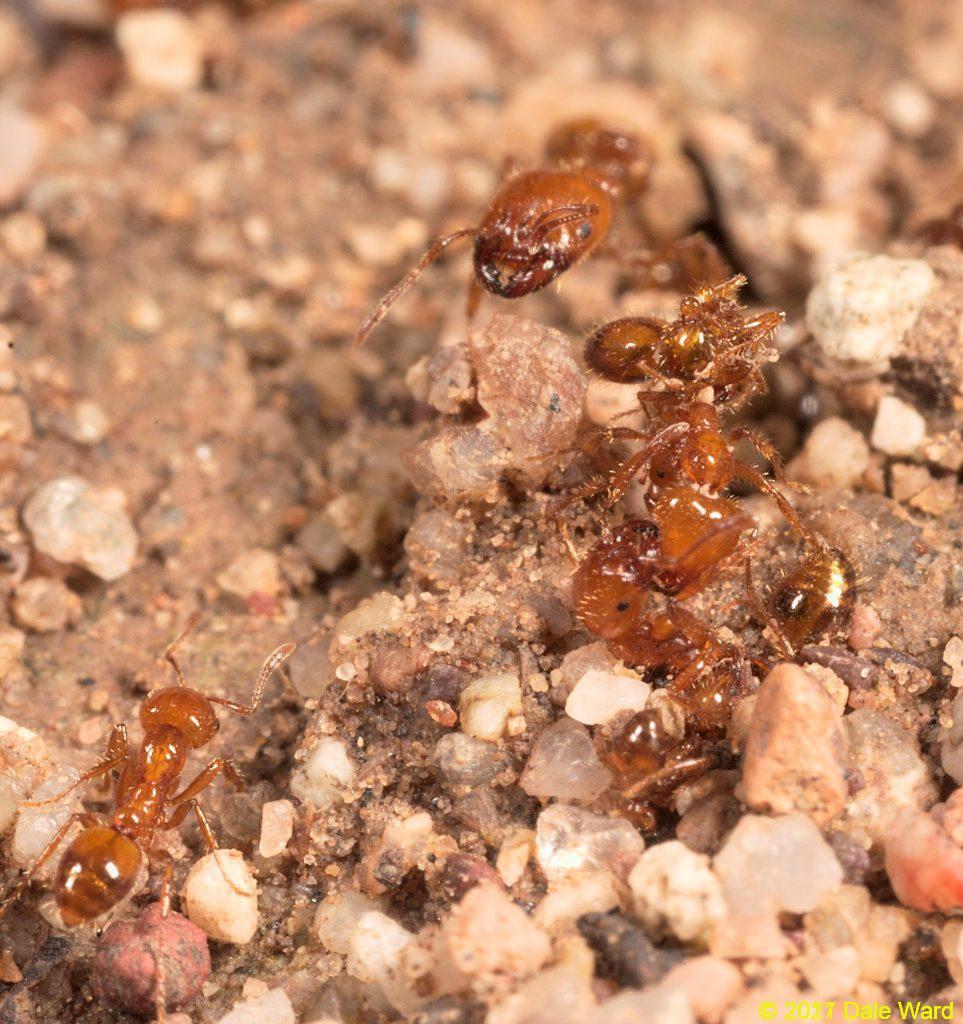 The carnage among the Golden Fire Ants (_Solenopsis_ _aurea_) workers. The worker with the large head, near the top of the photo, is a major.
The carnage among the Golden Fire Ants (_Solenopsis_ _aurea_) workers. The worker with the large head, near the top of the photo, is a major.
There are large number of species within the Phoridae family. The common name for them is “Scuttle Flies”. Some of them live and breed in drains, others have the charming name of “Corpse Flies”, for reasons you can probably guess.
And a lot of Phorid species have nothing to do with drains and corpses and things, but rather have larvae that are parasitic on other insects. Especially ants. Some of these parasitic Phorids are wingless, and live inside the ant colonies as unwelcome guests.
Still others find free roaming ants and attack them.
The details of this vary between species of Phorid Fly, but the general pattern is that the Phorid will fly at an ant and, quick as the blink of an eye, stab its ovipositor into the ant’s thorax, injecting an egg into the ant.
If you’re watching, the whole interaction could be mistaken for the fly bumping into the ant and flying away immediately, it’s that fast.
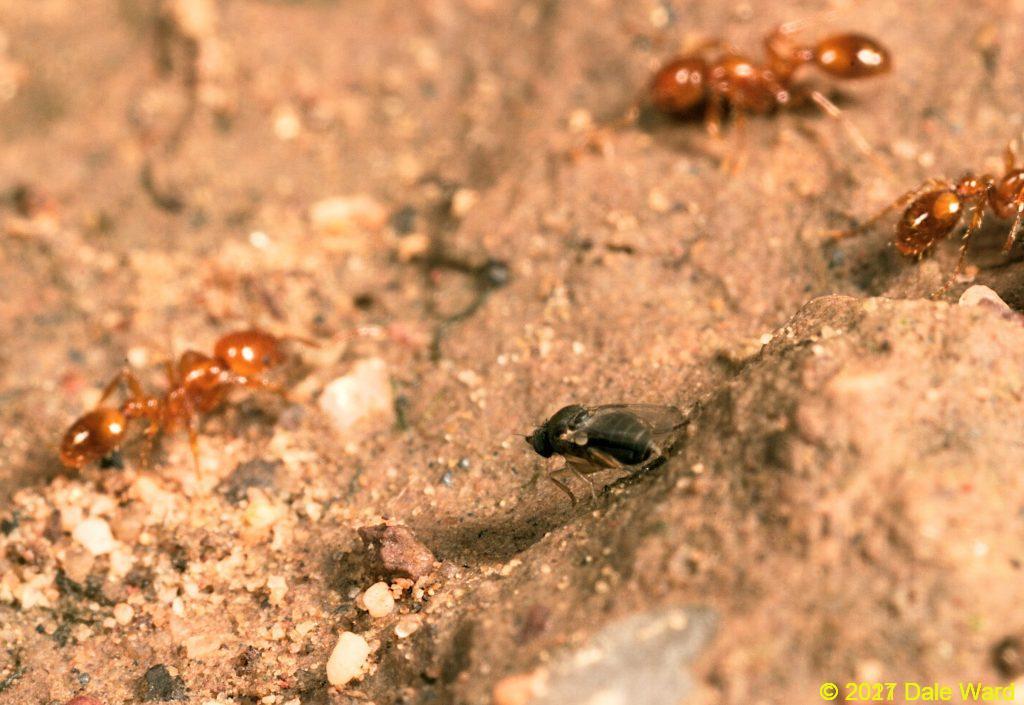 Phorid Fly watching _Solenopsis aurea_ workers pass by.
Phorid Fly watching _Solenopsis aurea_ workers pass by.
The egg hatches inside the ant’s thorax within the day, and the fly larva migrates out of the ant’s thorax, through the ant’s neck, and into the ant’s head.
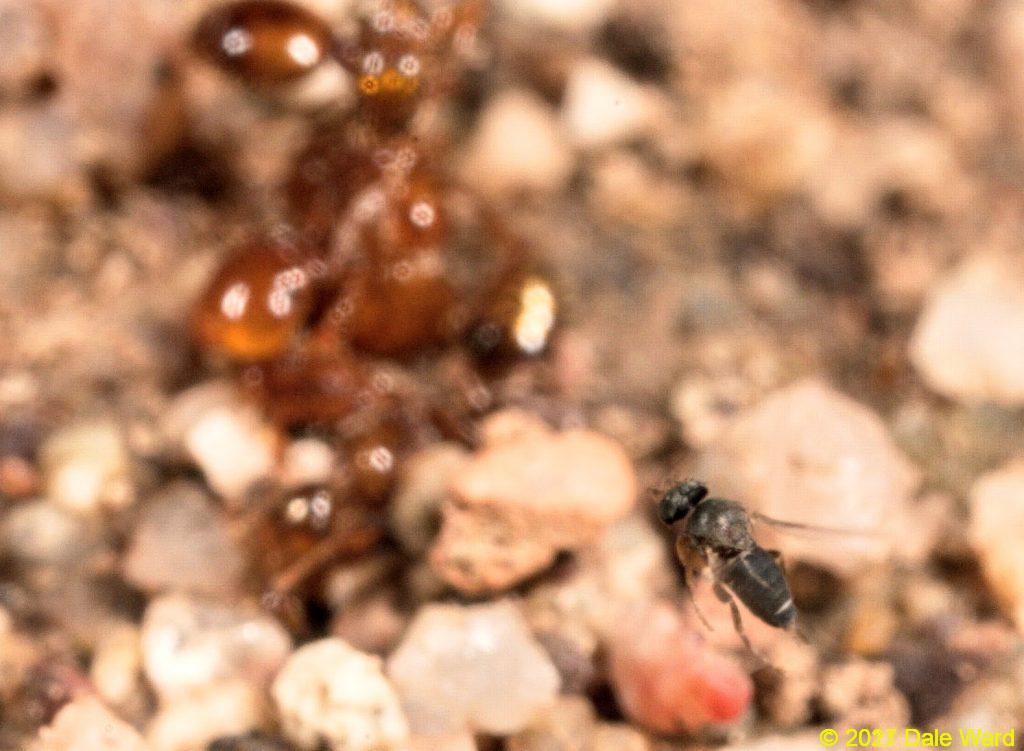 Phorid in flight. You can see the pile of damaged _Solenopsis aurea_ majors in the background.
Phorid in flight. You can see the pile of damaged _Solenopsis aurea_ majors in the background.
Once inside the ant’s head, the larva eats the contents of the ant’s head…muscles, brain, the whole nine yards. In a lot of species of Phorid, the ant stays more or less quietly within the ant nest while this munching goes on.
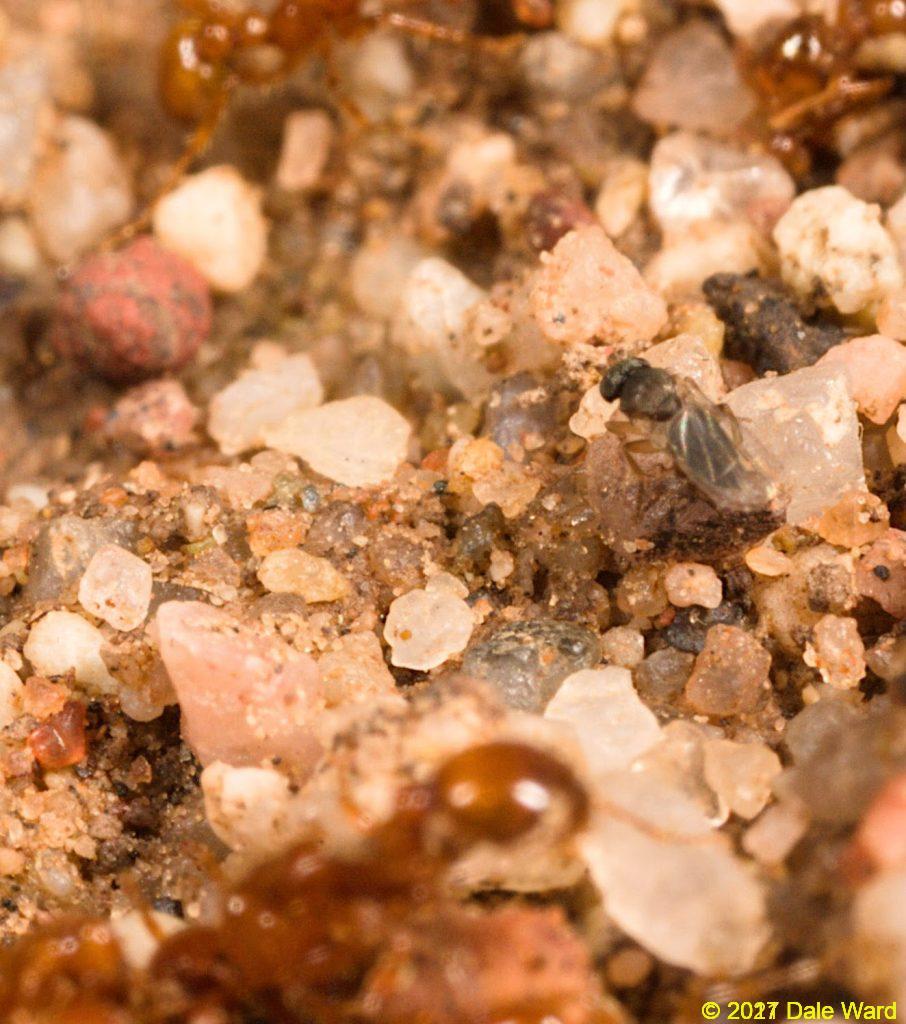 Another shot of a Phorid Fly biding its time, surrounded by _Solenopsis aurea_ workers.
Another shot of a Phorid Fly biding its time, surrounded by _Solenopsis aurea_ workers.
The fly larva continues to eat and grow within the ant’s head capsule, shedding its skin a couple of times. When the fly larva is ready to pupate, the larva somehow gets the mostly-brainless ant to walk out and away from the ant nest.
Then the larva secretes one or more enzymes which make the ant’s head fall off of its body(!), with the fly larva inside the mostly-empty head capsule. The ant’s mandibles, its jaws, have usually also fallen off at this point also, leaving a hole in the head capsule at the ant’s mouth. Sometimes the larva has secreted so much of the enzyme that the rest of the ant’s joints fall apart, as well. The fly larva pupates, and makes some breathing tubes out that extend out of the ant’s moth.
Eventually, the pupa transforms into an adult fly, the fly crawls out of the ant’s mouth, and flies away.
To start the cycle over again.
 Phorid Fly in flight, with injured _Solenopsis aurea_ workers in the background.
Phorid Fly in flight, with injured _Solenopsis aurea_ workers in the background.
There are lots…and lots…of Phorid Flies that are parasitic on ants. The flies are mostly very choosy about which ants they parasitize. Typically a species of fly will only parasitize a single species of ants, or at most a single closely related group of ant species.
The different species of Phorid flies find the ants in a variety of ways, but common attractants are ant venom and alarm pheromone. Both of these would be found in abundance around an area where two ant colonies had been fighting, such as in these photos.
The Phorids are also choosy about the size of the ants they parasitize, with each species of fly choosing only ants of a certain head width. For example, in Red Imported Fire Ants (Solenopsis invicta) there are at least eight different species of parasitic Phorid Fly. One species of fly takes ants with a head width of 2-3mm, another only takes ants with headwidths of 6-7mm, etc.
Another strange thing - in at least most Phorids, the sex of the fly is determined by the size of the head capsule in which the fly develops. Head capsules which are on the small size of the fly’s acceptable range yield male flies, and larger head capsules yield female flies.
I (of course!) did not get specimens of the Phorid Fly, but there’s a good chance this fly is Pseudacteon crawfordi. I’m basing that on the Pitts 2001 “A New Host Record for Pseudacteon crawfordi paper - that “new host” is Solenopsis aurea.
The effect of Phorid Flies on an ant colony is dramatic. Most of the ants will cower and hide, or attempt to run away. The presence of Phorid flies dramatically decreases the amount of foraging the ants are willing to do, by 50% or more in some cases. Researchers have introduced a variety of Phorid Flies that parasitize the Red Imported Fire Ant (Solenopsis invicta) in an attempt at bio-control. The last I heard, the introduction of the Phorids was successful, but had not had measurable effects on the Red Imported Fire Ants in the wild.
Postscript -
Dr Brian Brown, working in the Neotropics, filmed Dohrniphora Phorid Flies as they attacked Odontomachus ants. These Phorids were attracted to injured ants, so they were probably homing in on the alarm pheromone and venom of the Odontomachus ants. Rather than just lay eggs in the ants, though, the adult flies would tug and pull at the injured ants until they found one that was at just the right level of incapacitation. Then the fly would jump on the back of the ant’s head…and saw the ant’s head off. The fly would drag the head away and eat it itself, or lay an egg in it.
Here’s a video that Dr. Brown took of the interactions:
#https://www.youtube.com/watch?v=aOWEx2funGk
Sources:
Brown B, Kung G, Porras W (2015) A new type of ant-decapitation in the Phoridae (Insecta: Diptera).Biodiversity Data Journal 3: e4299. doi: 10.3897/BDJ.3.e429
Brown B, Kung G, Porras W (2015): Link to Brian Brown’s video of the decapitation behavior: https://www.youtube.com/watch?v=aOWEx2funGk
Hsieh, Hsun-Yi and Perfecto, Ivette (2012) Trait-Mediated Indirect Effects of Phorid Flies on Ants. Psyche: A Journal of Entomology. Special Issue: Ants and Their Parasites.
Mathis, Kaitlyn A. and Philpott, Stacy M. (2012) Current Understanding and Future Prospects of Host Selection, Acceptance, Discrimination, and Regulation of Phorid Fly Parasitoids That Attack Ants. Psyche: A Journal of Entomology. Special Issue: Ants and Their Parasites.
Pitts, James P., and Pitts-Singer, Theresa L (2001) A New Host Record for Pseudacteon crawfordi (Diptera: Phoridae). Florida Entomologist. Vol. 84, No. 2 (June 2001).
Tschinkel, Walter R. 2006. The Fire Ants. ISBN-10: 0674072405, ISBN-13: 978-0674072404. Note: This is a magnificent book. Both informative and entertaining.